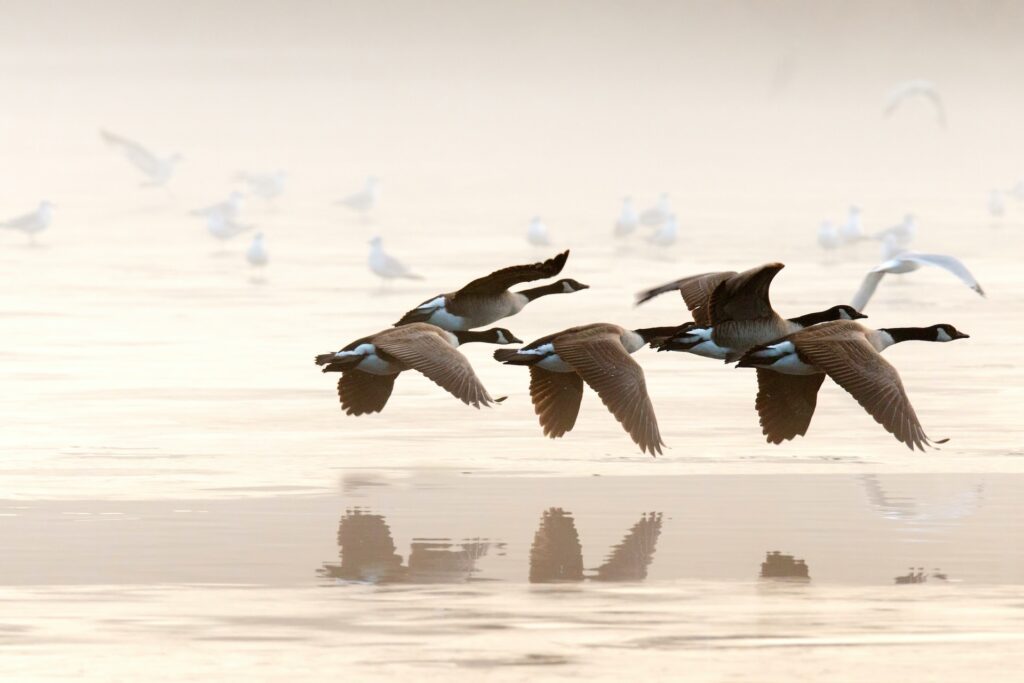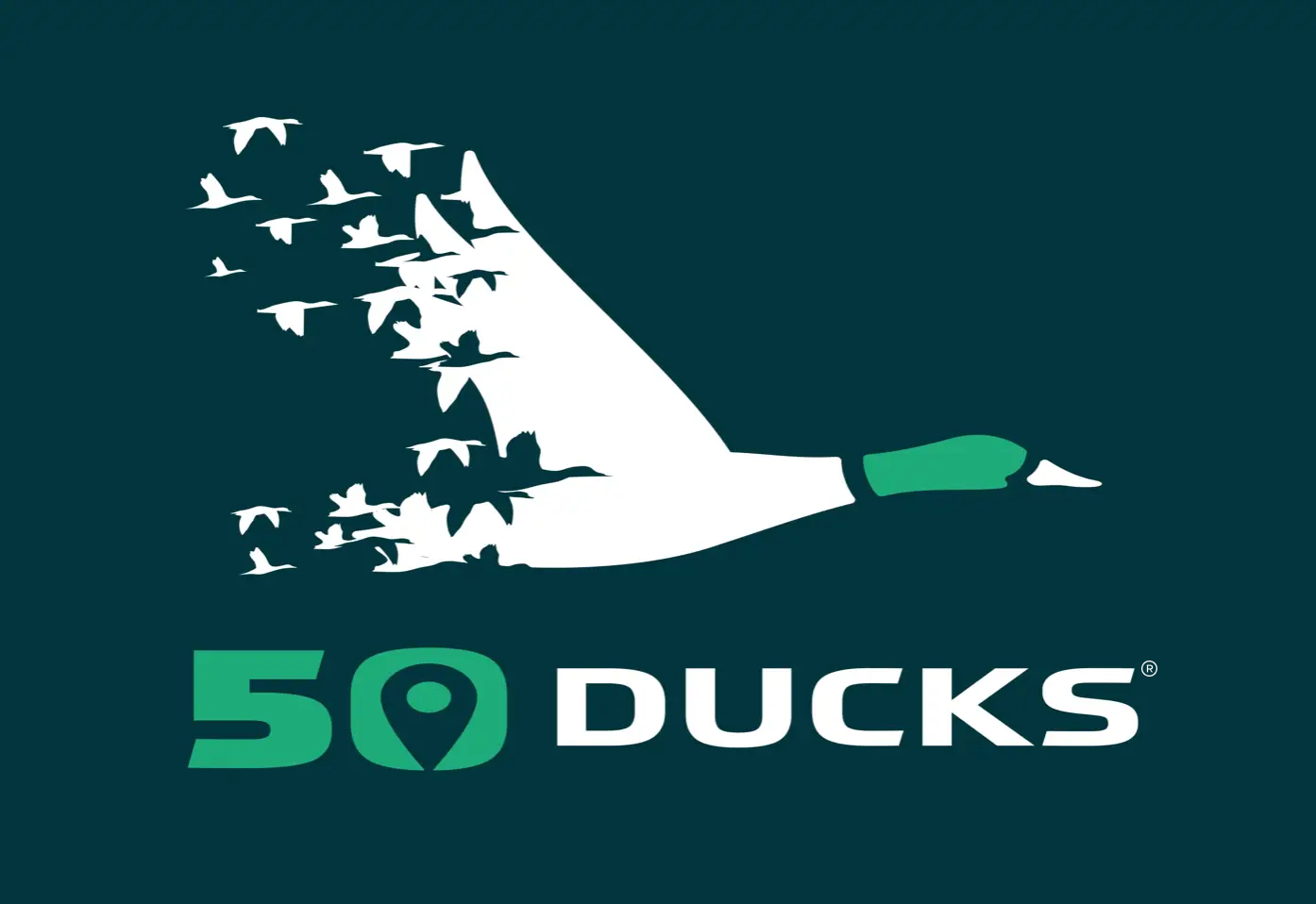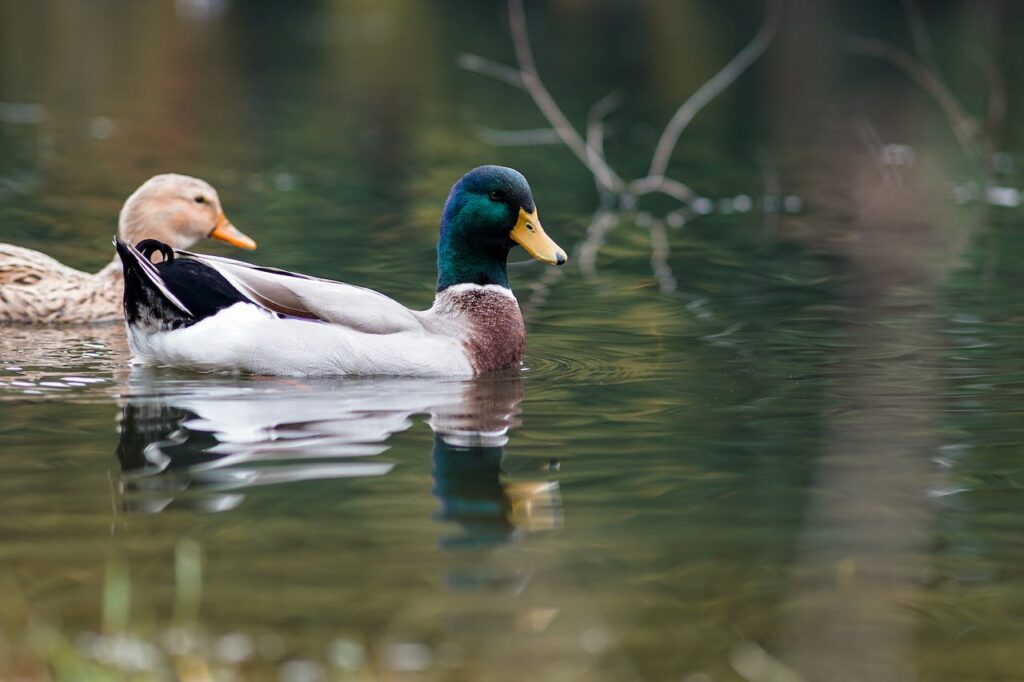Understanding the Incredible Migration of Waterfowl
Greer Smith
December 12, 2023

Bird migrations are an extraordinary phenomenon driven by internal clocks and hormonal responses that guide the intricate journey of ducks and geese. These avian voyagers travel vast distances to find vital resources for survival and reproduction.
In this post, we examine the migration of waterfowl to shed light on their critical role within ecosystems, particularly wetlands. As these birds navigate waterfowl migration routes, they transport various plant and animal species to other wetlands. Let’s peel back the layers of this awe-inspiring, bi-annual trek for a deeper understanding of our feathered friends!
The Basics of Migration
The migration of waterfowl is a testament to the instinctual response of birds to changing environmental conditions. As the crisp air of winter approaches, these majestic creatures gravitate toward southward-bound waterfowl migration routes to ensure their survival. Among the diverse species undertaking this venture are the mallards, blue-winged teal, northern pintails, and geese, each contributing their unique touch to the dynamic spectacle.
Guided by the variations in daylight, waterfowl’s biological clock propels them through stages of reproduction, molt, and premigratory body conditioning. The intricacies of their migration routes are shaped by the need for open, unfrozen waters and accessible food sources, and philopatry, showcasing their exceptional navigational skills.
Even before harsh conditions arrive, waterfowl start their journeys and reveal their innate senses. By understanding migration, we can unveil why birds stop in certain areas before they reach their final destination. Having accurate data regarding flight patterns allows conservationists to monitor valuable ecosystems and protect bottomland hardwood forests, marshes, and wetlands.
Factors Influencing Migration
As spring approaches and winter begins to fade, waterfowl migration takes flight amidst a perfect convergence of favorable conditions. Southerly winds, falling barometric pressure, and rising temperatures create an environment that beckons these remarkable birds on their northward journey.
Genetic variations within each population lend a unique touch to their migration patterns, influencing factors such as propensity, timing, routes, and journey behavior. In contrast, fall’s shorter days cast a nocturnal element over migrations, guided by north-to-northwest winds, falling temperatures, and high-pressure systems. These factors, underscored by drought and extreme weather conditions, help birds determine waterfowl migration routes.
While the migration of waterfowl may appear to run like a well-oiled machine, the landscape is challenging. Climate change interrupts delicate timing and migration numbers, affecting biodiversity on global and regional scales. Additionally, human interference due to pollution, urbanization, agriculture, and wetland drainage threaten vital stopover sites along their migratory routes.
Adaptations for Survival
For flocks of ducks, geese, swans, and other waterbirds, survival is a testament to several stunning adaptations. Physically, waterfowl possess wings and feathers uniquely shaped for the demands of long-distant waterfowl migration routes. Size and structure vary. Each species has adaptations that enable maximum speed, thrust, and lift.
Behaviorally, their response to weather conditions intricately influences the timing and distance of their movements. The cooperative nature of these birds becomes evident as they find solace in larger groups, utilizing the advantages of flock formations to conserve energy during extensive flights.The cooperative spirit of these birds shines when they gather in larger flocks. They skillfully utilize the dynamics of flock formations, particularly the iconic ‘V’ shape, to conserve energy during their long migratory journeys. This formation isn’t just a testament to their instinctual intelligence; it’s a strategic maneuver that allows each bird to benefit from the uplift of the bird in front of it, reducing their collective energy expenditure. This remarkable strategy underscores why we often see geese soaring across the sky in such an organized and efficient ‘V’ formation.
Fat stored during spring and summer prepares them for the journey and provides a vital buffer against the unpredictable weather events encountered along their migratory routes. Global researchers have conducted experiments by placing waterfowl in wind tunnels, closely examining their fat storage and utilization around vital organs. This research aims to gain deeper insights into the challenges of energy management during migration.
As a collective, the migration of waterfowl requires harmonious reactions. When spring arrives, waterfowl migrate northward to capitalize on nesting opportunities. As winter draws near, the decline in food availability, along with unknown internal instincts prompts their southward movement.
Waterfowl Navigational Instincts
To humans, the instinctual nature of waterfowl is mind-blowing. They possess navigational tools and sensory capabilities that allow them to reach their destinations year after year. Across vast landscapes, these birds utilize several visual and nonvisual orientation cues to guide their way. The sun, polarized light, stars, and familiar landmarks serve as pivotal guides, acting not just as compasses but as directional cues.
When we dig a little deeper, we find that some bird species utilize the axes of polarized light to aid in sun compass orientation and stars to provide a nocturnal roadmap for migration. Their sensory abilities are unfathomable. Yet, the migratory journey extends beyond the visible. Waterfowl possess an uncanny knack for finding their way “home” even when released in unfamiliar surroundings. How waterfowl achieve this remains a scientific puzzle, with many researchers attributing their navigational prowess to nonvisual cues, particularly the Earth’s magnetic field. Philopatry is the scientific term for returning to a birthplace year after year.
Great follow up here. Lets take it this route instead of utilizing landmarks.
Birdwatching & Migration Events
Immersing oneself in the captivating birdwatching world during waterfowl migration brings enchantment to the natural realm. For avid enthusiasts seeking prime opportunities to observe these magnificent creatures, the early morning hours, and early evenings are optimal conditions as birds are most active and vocal, especially during the spring and early summer.
The Central Valley of California emerges as a marvelous hub, hosting a plethora of wintering waterfowl, making it a must-visit destination for birdwatchers. Other notable regions, such as North Dakota, Louisiana, and the Texas Panhandle, boast impressive numbers of migrating and wintering ducks, creating ideal havens for birdwatching enthusiasts.
Engaging in renowned bird watching events and festivals, including the Everglades Birding Festival, Indiana Dunes Birding Festival, Morro Bay Winter Bird Festival, Great Salt Lake Birding Festival, and Annual Rio Grande Valley Birding Festival, provides a unique platform to witness an array of species along waterfowl migration routes.
For beginners interested in this new hobby, cultivating a morning routine, attending birding events, and utilizing bird guides and binoculars become invaluable tools that enhance the experience and deepen understanding of waterfowl and their remarkable bi-annual journeys.
Wrapping Up
In conclusion, our exploration of waterfowl migration illuminates the extraordinary feats and adaptations of avian species. From navigating using celestial cues to their incredible ability to find their way home, waterfowl migration is a testament to nature’s wonders.
As we immerse ourselves in the joy of birdwatching and witness the awe-inspiring migration events, let us also recognize the importance of protecting waterfowl and their habitats.
By joining forces with 50 Ducks and our partners, we can track waterfowl migration routes in real time, like never before, and ensure a thriving future for wetland ecosystems and stopover points. Together, let’s celebrate the resilience and beauty of our feathered friends and inspire generations to come.

